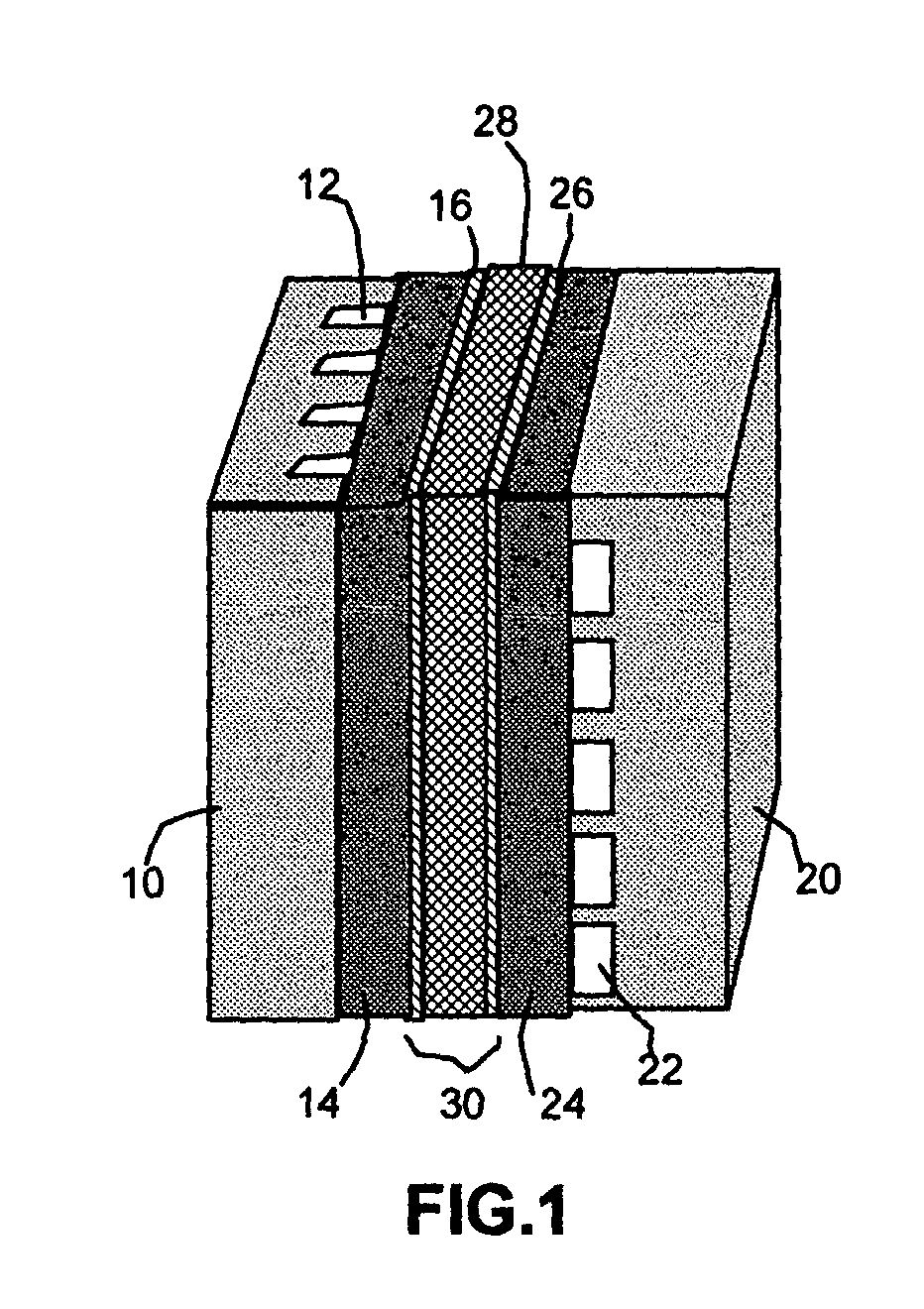Self-moisturizing proton exchange membrane, membrane-electrode assembly and fuel cell
a proton exchange membrane and electrolyte technology, applied in the field of pem, can solve the problems of reducing the performance of the membrane, affecting the performance of the cell, and increasing the resistance power loss,
- Summary
- Abstract
- Description
- Claims
- Application Information
AI Technical Summary
Benefits of technology
Problems solved by technology
Method used
Image
Examples
example 1
A solution containing 240 mg of poly(perfluoro sulfonic acid) (PPSA) and 120 mg of zinc chloride (a deliquescent material) in 3.0 ml of ethanol was prepared. This solution was then cast onto a piece of glass with the solvent evaporated in a chemical fume hood to form a layer of PPSA-ZnCl2 mixture (sample 1B). A baseline sample (sample 1A) containing only PPSA, without any zinc chloride, was prepared by following a similar procedure. Both the mixture sample and the PPSA-only sample were placed in a low-humidity oven maintained at 80° C. (a typical fuel cell operating temperature) for two weeks. The mixture (sample 1B or the PEM composition) appeared to maintain a good level of moisture, but the baseline sample (sample 1A) was dry and rigid.
example 2
A perfluoro sodium sulfonate type ion exchange polymer material in a powder form having an equivalent weight of 1080 g / eq represented by the following formula (VI) was prepared:
wherein x / y ratio is 6.36. The prepared ion exchange membrane was dipped in a swelling treatment liquid (ethylene glycol) at a constant temperature of 130° for 3 hours. Next, the membrane was dipped in 0.1 mol / l sodium hydroxide at 90° C. for 12 hours, dipped in a 1 mol / l sulfuric acid solution at 60° C. for 12 hours, and then was boiled in a mixture of water and ethanol for 2 hours. The resulting sample 2A has a structure represented by Formula I, with Na+ being replaced by H+. The above procedure is an ion exchange treatment.
Sample 2B was prepared in a similar manner as sample 2A, with the exception that a certain amount of calcium chloride was added to the water-ethanol mixture to obtain a slurry containing the polymer, the deliquescent material (CaCl2), and the liquid mixture. The slurry was cast on...
example 3
Sample 3A and 3B were prepared by using procedures similar to those for samples 2A and 2B, respectively, with the exception that the starting material was represented by formula VII:
and the resulting polymer after the ion exchange treatment was represented by formula VIII:
This is a special case of Formula V with a=0 and b=2. Again, with the presence of a deliquescent material, sample 3B maintains moisture much more effectively than does sample 3A.
PUM
| Property | Measurement | Unit |
|---|---|---|
| proton-conducting | aaaaa | aaaaa |
| electronically conducting | aaaaa | aaaaa |
| chemical energy | aaaaa | aaaaa |
Abstract
Description
Claims
Application Information
 Login to View More
Login to View More - R&D
- Intellectual Property
- Life Sciences
- Materials
- Tech Scout
- Unparalleled Data Quality
- Higher Quality Content
- 60% Fewer Hallucinations
Browse by: Latest US Patents, China's latest patents, Technical Efficacy Thesaurus, Application Domain, Technology Topic, Popular Technical Reports.
© 2025 PatSnap. All rights reserved.Legal|Privacy policy|Modern Slavery Act Transparency Statement|Sitemap|About US| Contact US: help@patsnap.com



